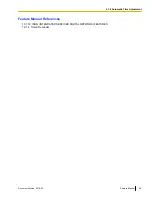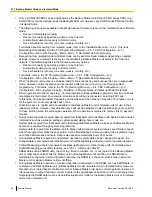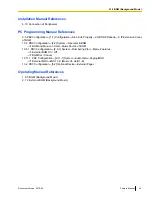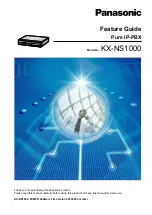
1.
Caller ID Features
There are three features which can receive Caller ID information. The available feature depends on the
type of CO line receiving the call.
Feature
Description
Details in
Caller ID
Receives caller information sent from the
telephone company over analog CO lines.
–
Calling Line Identification
Presentation (CLIP)
Receives caller information sent from the
telephone company over ISDN lines.
–
Automatic Number
Identification (ANI)
Receives caller information sent from the
telephone company over T1 lines (stacking
connection only).
–
2.
Caller ID-Related Features
Feature
Description
Details in
Calling Line Identification
(CLI) Distribution
Caller ID information received by the PBX is used
to direct calls from specific callers to specific
destinations. The caller’s telephone number and a
destination must be assigned in the System Speed
Dialing Table.
®
(Calling Line
Identification)
Distribution
Incoming Call Log
Caller information is automatically recorded in the
call log of the extension which received the call.
This information can be used to view a record of
incoming calls or make calls to any number in the
call log.
®
3.
Automatic Caller ID Number Modification
When a call is received, the PBX can automatically modify the caller’s telephone number according to a
preprogrammed set of rules (Caller ID Modification Table). This modified number will be automatically
stored in the extension’s Incoming Call Log, allowing the extension user to make a call to this number later
without worrying about CO Line Access numbers, area codes, etc.
Each trunk group can be assigned a modification table. Each table has ten formulas for modifying local/
international numbers, and one formula for modifying long distance numbers. When a call is received, the
PBX compares the received telephone number to the area codes programmed under "Local/International
Call Data" first. If a match is not found, the telephone number will be modified according to the method
programmed under "Long Distance Code".
After the caller’s number is modified by the Length of Digits modification tables or CLIP modification tables,
the PBX checks the leading digits of the modified number for an area code programmed in the Caller ID
modification table assigned to that trunk group. For more information, refer to 11.1.3 PBX
Configuration—[3-1-3] Group—Trunk Group—Caller ID Modification—Leading Digits in PC Programming
Manual.
Document Version 2016-03
Feature Manual
49
4.1.3 Caller ID
Summary of Contents for KX-NS1000
Page 15: ...Section 1 For Your Safety Document Version 2016 03 Feature Manual 15...
Page 18: ...18 Feature Manual Document Version 2016 03 1 1 1 For Your Safety...
Page 19: ...Section 2 Features and Configurations A Document Version 2016 03 Feature Manual 19...
Page 36: ...36 Feature Manual Document Version 2016 03 2 1 8 Automatic Time Adjustment...
Page 37: ...Section 3 Features and Configurations B Document Version 2016 03 Feature Manual 37...
Page 44: ...44 Feature Manual Document Version 2016 03 3 1 2 BGM Background Music...
Page 45: ...Section 4 Features and Configurations C Document Version 2016 03 Feature Manual 45...
Page 89: ...Section 5 Features and Configurations D Document Version 2016 03 Feature Manual 89...
Page 122: ...122 Feature Manual Document Version 2016 03 5 1 18 DSP Resource Usage...
Page 123: ...Section 6 Features and Configurations E Document Version 2016 03 Feature Manual 123...
Page 137: ...Section 7 Features and Configurations F Document Version 2016 03 Feature Manual 137...
Page 159: ...Section 8 Features and Configurations G Document Version 2016 03 Feature Manual 159...
Page 165: ...Section 9 Features and Configurations H Document Version 2016 03 Feature Manual 165...
Page 172: ...172 Feature Manual Document Version 2016 03 9 1 6 Hot Line...
Page 173: ...Section 10 Features and Configurations I Document Version 2016 03 Feature Manual 173...
Page 217: ...Section 11 Features and Configurations K Document Version 2016 03 Feature Manual 217...
Page 220: ...220 Feature Manual Document Version 2016 03 11 1 1 KX UT Series SIP Phones...
Page 221: ...Section 12 Features and Configurations L Document Version 2016 03 Feature Manual 221...
Page 228: ...228 Feature Manual Document Version 2016 03 12 1 4 Local Alarm Information...
Page 229: ...Section 13 Features and Configurations M Document Version 2016 03 Feature Manual 229...
Page 237: ...Section 14 Features and Configurations O Document Version 2016 03 Feature Manual 237...
Page 252: ...252 Feature Manual Document Version 2016 03 14 1 9 Operator Features...
Page 253: ...Section 15 Features and Configurations P Document Version 2016 03 Feature Manual 253...
Page 331: ...Section 16 Features and Configurations Q Document Version 2016 03 Feature Manual 331...
Page 333: ...Section 17 Features and Configurations R Document Version 2016 03 Feature Manual 333...
Page 340: ...340 Feature Manual Document Version 2016 03 17 1 3 Room Status Control...
Page 341: ...Section 18 Features and Configurations S Document Version 2016 03 Feature Manual 341...
Page 364: ...364 Feature Manual Document Version 2016 03 18 1 12 Syslog Record Management...
Page 365: ...Section 19 Features and Configurations T Document Version 2016 03 Feature Manual 365...
Page 385: ...Section 20 Features and Configurations U Document Version 2016 03 Feature Manual 385...
Page 443: ...Section 21 Features and Configurations V Document Version 2016 03 Feature Manual 443...
Page 448: ...448 Feature Manual Document Version 2016 03 21 1 2 Virtual PS...
Page 449: ...Section 22 Features and Configurations W Document Version 2016 03 Feature Manual 449...
Page 459: ...Section 23 Appendix Document Version 2016 03 Feature Manual 459...
Page 481: ...Document Version 2016 03 Feature Manual 481 Notes...


































